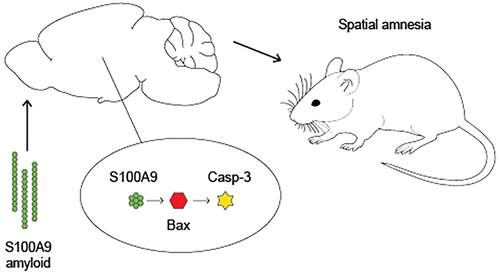当前位置:
X-MOL 学术
›
ACS Chem. Neurosci.
›
论文详情
Our official English website, www.x-mol.net, welcomes your feedback! (Note: you will need to create a separate account there.)
Intranasally Administered S100A9 Amyloids Induced Cellular Stress, Amyloid Seeding, and Behavioral Impairment in Aged Mice
ACS Chemical Neuroscience ( IF 5 ) Pub Date : 2018-04-04 00:00:00 , DOI: 10.1021/acschemneuro.7b00512 Igor A. Iashchishyn 1, 2 , Marina A. Gruden 3 , Roman A. Moskalenko 1, 4 , Tatiana V. Davydova 5 , Chao Wang 1 , Robert D. E. Sewell 6 , Ludmilla A. Morozova-Roche 1
ACS Chemical Neuroscience ( IF 5 ) Pub Date : 2018-04-04 00:00:00 , DOI: 10.1021/acschemneuro.7b00512 Igor A. Iashchishyn 1, 2 , Marina A. Gruden 3 , Roman A. Moskalenko 1, 4 , Tatiana V. Davydova 5 , Chao Wang 1 , Robert D. E. Sewell 6 , Ludmilla A. Morozova-Roche 1
Affiliation

|
Amyloid formation and neuroinflammation are major features of Alzheimer’s disease pathology. Proinflammatory mediator S100A9 was shown to act as a link between the amyloid and neuroinflammatory cascades in Alzheimer’s disease, leading together with Aβ to plaque formation, neuronal loss and memory impairment. In order to examine if S100A9 alone in its native and amyloid states can induce neuronal stress and memory impairment, we have administered S100A9 species intranasally to aged mice. Single and sequential immunohistochemistry and passive avoidance behavioral test were conducted to evaluate the consequences. Administered S100A9 species induced widespread cellular stress responses in cerebral structures, including frontal lobe, hippocampus and cerebellum. These were manifested by increased levels of S100A9, Bax, and to a lesser extent activated caspase-3 immunopositive cells. Upon administration of S100A9 fibrils, the amyloid oligomerization was observed in the brain tissues, which can further exacerbate cellular stress. The cellular stress responses correlated with significantly increased training and decreased retention latencies measured in the passive avoidance test for the S100A9 treated animal groups. Remarkably, the effect size in the behavioral tests was moderate already in the group treated with native S100A9, while the effect sizes were large in the groups administered S100A9 amyloid oligomers or fibrils. The findings demonstrate the brain susceptibility to neurotoxic damage of S100A9 species leading to behavioral and memory impairments. Intranasal administration of S100A9 species proved to be an effective method to study amyloid induced brain dysfunctions, and S100A9 itself may be postulated as a target to allay early stage neurodegenerative and neuroinflammatory processes.
中文翻译:

鼻内给药的S100A9淀粉样蛋白诱导衰老小鼠的细胞应激,淀粉样蛋白植入和行为障碍
淀粉样蛋白形成和神经炎症是阿尔茨海默氏病病理学的主要特征。促炎性介质S100A9被证明在阿尔茨海默氏病的淀粉样蛋白和神经炎性级联反应之间起着联系,与Aβ一起导致斑块形成,神经元丢失和记忆障碍。为了检查S100A9单独处于其天然状态和淀粉样状态是否可以诱导神经元应激和记忆障碍,我们已向衰老小鼠鼻内施用了S100A9物种。进行了单次和连续的免疫组织化学和被动回避行为测试以评估后果。施用的S100A9物种在大脑结构(包括额叶,海马和小脑)中诱导了广泛的细胞应激反应。这些表现为S100A9,Bax,并在较小程度上激活了caspase-3免疫阳性细胞。施用S100A9原纤维后,在脑组织中观察到淀粉样蛋白低聚,这可进一步加剧细胞应激。在被动回避测试中,对于S100A9治疗的动物组,细胞应激反应与训练显着增加和保留潜伏期降低相关。值得注意的是,在行为测试中,用天然S100A9治疗的组中的效应量已经中等,而在使用S100A9淀粉样低聚物或原纤维的组中,效应量很大。这些发现证明大脑对S100A9物种造成神经毒性损害的易感性,从而导致行为和记忆力受损。
更新日期:2018-04-04
中文翻译:

鼻内给药的S100A9淀粉样蛋白诱导衰老小鼠的细胞应激,淀粉样蛋白植入和行为障碍
淀粉样蛋白形成和神经炎症是阿尔茨海默氏病病理学的主要特征。促炎性介质S100A9被证明在阿尔茨海默氏病的淀粉样蛋白和神经炎性级联反应之间起着联系,与Aβ一起导致斑块形成,神经元丢失和记忆障碍。为了检查S100A9单独处于其天然状态和淀粉样状态是否可以诱导神经元应激和记忆障碍,我们已向衰老小鼠鼻内施用了S100A9物种。进行了单次和连续的免疫组织化学和被动回避行为测试以评估后果。施用的S100A9物种在大脑结构(包括额叶,海马和小脑)中诱导了广泛的细胞应激反应。这些表现为S100A9,Bax,并在较小程度上激活了caspase-3免疫阳性细胞。施用S100A9原纤维后,在脑组织中观察到淀粉样蛋白低聚,这可进一步加剧细胞应激。在被动回避测试中,对于S100A9治疗的动物组,细胞应激反应与训练显着增加和保留潜伏期降低相关。值得注意的是,在行为测试中,用天然S100A9治疗的组中的效应量已经中等,而在使用S100A9淀粉样低聚物或原纤维的组中,效应量很大。这些发现证明大脑对S100A9物种造成神经毒性损害的易感性,从而导致行为和记忆力受损。



























 京公网安备 11010802027423号
京公网安备 11010802027423号